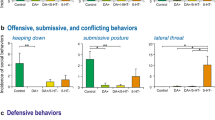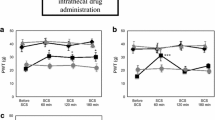Summary
The role of ascending and descending serotonergic pathways in the antinociceptive effect of baclofen was examined by lesioning specific pathways with the neurotoxin 5,7-dihydroxytryptamine (5,7-DHT). Antinociception in rats was assessed using the tail flick and hot plate tests 3/4 and 10/11 days after lesioning and the placement of lesions verified by analysis of serotonin (5-HT) in brain and spinal cord. Lesions to the ventromedial tegmentum depleted 5-HT selectively in brain and inhibited the antinociceptive effect of baclofen in the tail flick test 3/4 but not 10/11 days after lesioning. Lesions to the nucleus raphe medianus produced a marked depletion of 5-HT in the hippocampus and produced the same effect on baclofen. Lesions to the nucleus raphe dorsalis were less selective, depleting 5-HT in a number of brain regions and in the spinal cord, and inhibited the antinociceptive effect of baclofen at the later but not the earlier time interval. Lesions to descending pathways by microinjection of 5,7-DHT into the ventral raphe or nucleus raphe magnus did not affect the action of baclofen significantly. Lesions to both ascending and descending pathways by intracerebroventricular 5,7-DHT increased the effect of baclofen. The hot plate test generally was less sensitive to these manipulations, although changes parallel to the tail flick test were observed in a number of instances. Both the destruction of 5-HT pathways and development of supersensitivity at 5-HT receptors may contribute to the interactions observed.
Similar content being viewed by others
References
Adler M, Kostowski W, Recchia M, Samanin R (1975) Anatomical specificity as the critical determinant of the interrelationship between raphe lesions and morphine analgesia. Eur J Pharmacol 32:39–44
Archer T, Jonsson G, Minor BG, Post C (1986) Noradrenergicserotonergic interactions and nociception in the rat. Eur J Pharmacol 120:295–307
Bartolini A, Malmberg P, Bartolini R, Giotti A (1982) Effect of antimigrane drugs on non-opioid analgesia. Adv Neurol 33:89–97
Baumeister HA, Frye GD (1986) Involvement of the midbrain reticular formation in self injurious behaviour, stereotyped behaviour, and analgesia induced by intranigral microinjection of muscimol. Brain Res 369:231–242
Bläsig J, Reinhold K, Herz A (1973) Effect of 6-hydroxydopamine, 5,6-dihydroxytryptamine and raphe lesions on the antinociceptive actions of morphine in rats. Psychopharmacology 31:111–119
Bowery NG, Hill DR, Hudson AL, Doble A, Middlemiss DN, Shaw J, Turnbull M (1980) (−)Baclofen decreases neurotransmitter release in the mammalian CNS by an action at a novel GABA receptor. Nature 283:92–94
Bowker RM, Westlund KN, Coulter JD (1981) Origins of serotonergic projections to the spinal cord in rats. An immunocytochemical-retrograde transport study. Brain Res 226:187–199
Chance WT, Krynock GM, Rosecrans JA (1978) Effects of medial raphe and raphe magnus lesions on the analgesic activity of morphine and methadone. Psychopharmacology 56:133–137
Dahlström A, Fuxe K (1964) Evidence for the existence of monoamine containing neurons in the central nervoussystem. I. Demonstration of monoamines in the cell bodies of brainstem neurons. Acta Physiol Scand 62 Suppl 232:1–55
Dahlstrom A, Fuxe K (1965) Evidence for the existence of monoamine neurons in the central nervous system. I1. Experimentally induced changes in the intra-neural amine levels. Acta Physiol Scand 64 Suppl 247:1–36
DaPrada M, Keller HH (1976) Baclofen and γ-hydroxybutyrate: similar effects on cerebral dopamine neurones. Life Sci 19: 1253–1264
Deakin JFW, Dostrovsky JO (1978) Involvement of the periaqueductal grey matter and spinal 5-hydroxytryptaminergic pathways in morphine analgesia: effects of lesions and 5-hydroxytryptamine depletion. Br J Pharmacol 63:159–165
Drust EG, Conner JD (1983) Pharmacological analysis of shaking behavior induced by enkephalins, thyrotropin-released hormone or serotonin in rats: Evidence for different mechanisms. J Pharmacol Exp Ther 224:148–154
Duan J, Sawynok J (1987) Enhancement of clonidine-induced analgesia by lesions induced with spinal and intracerebroventricular administration of 5,7-dihydroxytryptamine. Neuropharmacology 26:323–329
Fuxe K, Jonsson G (1974) Further mapping of central 5-hydroxytryptamine neurons: studies with the neurotoxic dihydroxytryptamines. Adv Biochem Psychopharmacol 10:1–12
Genovese E, Zonta N, Mantegazza P (1973) Decreased antinociceptive activity of morphine in rats pretreated intraventricularly with 5,6-dihydroxytryptamine, a long-lasting selective depletor of brain serotonin. Psychopharmacology 32:359–364
Geyer MA, Puerto A, Dawsey WJ, Knapp S, Bullard P, Mandell AJ (1976) Histologic and enzymatic studies of the mesolimbic and mesostriatal serotonergic pathways. Brain Res 106:241–256
Heal DJ, Philpot J, Molyneux SG, Metz A (1985) Intracerebroventricular administration of 5,7-dihydroxytryptamine to mice increases both head twitch response and the number of cortical 5-HT2 receptors. Neuropharmacology 24:1201–1205
Howe JR, Yaksh TL (1982) Changes in sensitivity to intrathecal norepinephrine and serotonin after 6-hydroxydopamine (6-OHDA), 5,6-dihydroxytryptamine sensitivity (5,6-DHT) or repeated amine administration. J Pharmacol Exp Ther 220:311–321
Jacobs BL, Wise WD, Taylor KM (1974) Differential behavioural and neurochemical effects following lesions of the dorsal or median raphe nuclei in rats. Brain Res 79:353–361
Jonsson G (1980) Chemical neurotoxins as denervation tools in neurobiology. Annu Rev Neurosci 3:169–187
König JFR, Klippel RA (1963) The rat brain. A stereotaxic atlas of the forebrain and lower parts of the brain stem. Williams and Wilkins, Baltimore
Kuraishi Y, Harada Y, Arantani S, Satoh M, Takagi H (1983) Separate involvement of the spinal noradrenergic and serotonergic systems in morphine analgesia: the differences in mechanical and thermal algesic tests. Brain Res 273:245–252
Levy RA, Proudfit HK (1979) Analgesia produced by microinjection of baclofen and morphine at brain stem sites. Eur J Pharmacol 57:43–55
Leysen JE, VanGompel P, Verwimp M, Niemegeers CJE(1983) Role and localization of serotonin2 (S2)-receptor-binding sites: Effects of neuronal lesions. In: Mandel EP, DeFendis FV (eds) CNS receptors from molecular pharmacology to behavior. Raven Press, New York, pp 373–383
Lim CR, Garant DG, Gale K (1985) GABA agonist induced analgesia elicited from lateral preoptic area in the rat. Eur J Pharmacol 107:91–94
Lorens SA, Guldberg HC (1974) Regional 5-hydroxytryptamine following selective mid-brain raphe lesions in the rat. Brain Res 78:45–56
Lorens SA, Yunger LM (1974) Morphine analgesia, two-way avoidance and consummatory behavior following lesions in the midbrain raphe nuclei of the rat. Pharmacol Biochem Behav 2:215–221
Metz A, Goodwin GM, Greon AR (1985) The administration of baclofen to mice increases 5-HT2-mediated head-twitch behaviour and 5-HT2 receptor number in frontal cortex. Neuropharmacology 24:357–360
Mohrland JS, Gebhart GF (1980) Effect of selective destruction of serotonergic neurons in nucleus raphe magnus on morphineinduced antinociception. Life Sci 27:2627–2632
Pellegrino LJ, Pellegrino AS, Cushman AJ (1979) A stereotaxic atlas of the rat brain. Plenum Press, New York
Proudfit HK (1980) Effects of raphe magnus and raphe pallidus lesions on morphine-induced analgesia and spinal cord monoamines. Pharmacol Biochem Behav 13:705–714
Proudfit HK, Levy RA (1978) Delimitation of neuronal substrates necessary for the analgesic action of baclofen and morphine. Eur J Pharmacol 47:159–166
Romandini S, Esposito E, Samanin R (1986a) Studies on the separate roles of forebrain and spinal serotonin in morphine analgesia. Naunyn-Schmiedeberg's Arch Pharmacol 332:208–212
Romandini S, Pich EM, Esposito E, Kruszewska A, Samanin R (1986b) The effect of different lesions of the median raphe on morphine analgesia. Brain Res 377:351–354
Romandini S, Pich EM, Esposito E, Kruszewska AZ, Samanin R (1986c) The effect of intracerebroventricular 5,7-dihydroxytryptamine on morphine analgesia is time-dependent. Life Sci 38:869–875
Samanin R, Gumulka W, Valzelli L (1970) Reduced effect of morphine in midbrain raphe lesioned rats. Eur J Pharmacol 10:339–343
Sasa M, Munekiyo K, Osumi Y, Takaori S (1977) Attenuation of morphine analgesia in rats with lesions of the locus coeruleus and dorsal raphe nucleus. Eur J Pharmacol 42:53–62
Sawynok J (1987) GABAergic mechanisms of analgesia: An updata. Pharmacol Biochem Behav 26:463–474
Sawynok J, Dickson C (1985) Evidence for the involvement of descending noradrenergic pathways in the antinociceptive effect of baclofen. Brain Res 335:89–97
Sawynok J, Reid A (1986) Role of ascending and descending noradrenergic pathways in the antinociceptive effect of baclofen and clonidine. Brain Res 386:341–350
Schlicker E, Classen K, Göthert M (1984) GABAB receptor-mediated inhibition of serotonin release in the rat brain. Naunyn-Schmiedeberg's Arch Pharmacol 326:99–105
Vogt M (1974) The effect of lowering the 5-hydroxytryaptamine content of the rat spinal cord on analgesia produced by morphine. J Physiol (London) 236:483–498
Waldmeier PC, Fehr B (1978) Effects of baclofen and γ-hydroxybutyrate on rat striatal and mesolimbic 5-HT metabolism. Eur J Pharmacol 49:177–184
Zorn SH, Enna SJ (1985) The effect of mouse spinal cord transection on the antinociceptive response to the γ-aminobutyric acid agonists THIP (4,5,6,7-tetrahydroisoxazolo (5,4-c) pyridine-3-ol) and baclofen. Brain Res 338:380–383
Author information
Authors and Affiliations
Additional information
Send offprint requests to J. Sawynok
Rights and permissions
About this article
Cite this article
Sawynok, J., Reid, A. Role of ascending and descending serotonergic pathways in the antinociceptive effect of baclofen. Naunyn-Schmiedeberg's Arch Pharmacol 337, 359–365 (1988). https://doi.org/10.1007/BF00169524
Received:
Accepted:
Issue Date:
DOI: https://doi.org/10.1007/BF00169524




